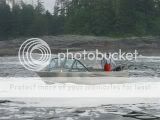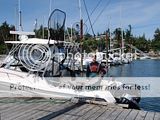Net pen rearing is not new for pacific salmon. Primarily done in saltwater, but not always. For steelhead, lake pens as well as saltwater short term pen rearing is occasionally used. But I am a little unsure about what you mean by hatcheries not able to raise steelhead and salmon. In some rivers, it been spectacular. Just think what the SS, Puntledge, Quinsam or Vedder would be like with no hatchery program.... But you are right about the returns, in general, not happening. With steelhead, in order to get decent numbers of fish returning, they have to release LARGE numbers. Apart from the obvious cost associated with a large rearing program, there are other biological factors that need to be considered....things like how many wild fish can be taken for broodstock before it brings up genetic concerns etc. With the advent of the POST program, net penning of steelhead to get them past that critical initial transition stage while monitoring thier survivals after release is being tried. Also the summer run fish that are being released in the Campbell are net penned in a lake as are other north island hatchery steelies. But, because of the abysmal returns, the FWFS has put thier main effort into rearing and stocking lake fish as they get the best "bang for thier buck" . No mysterious "ocean survivals" here.
As far as Nile Creek-- those guys have maxed the habitat with thier efforts AND Nile Creek is groundwater fed. Ground water is like gold when it comes to raising fish.
Why did they get so many pinks back??? Well, there is a theory that the extreme low water in the early fall when the pinks returned to the area affected those fish that could not get into thier natal streams. Fanny Bay Enhancement Society was expecting a decent return of pinks last fall too. The pinks showed up in late August, early Sept along the beaches of the Baynes Sound streams. But they would have needed running shoes to get up stream. Salmon will only wait so long before they go looking for the next available suitable stream, especially if they are being harassed by seals.
Well on the northern end of Baynes Sound , the Puntledge had a pretty decent pink return. To the south, that little ground water stream, Nile Creek, had what was probably its best pink return ever! Wall to wall fish. So were they all strays-- I doubt that, but I would lay odds that a bunch were. But---- pick a number!
20ft Alumaweld Intruder



